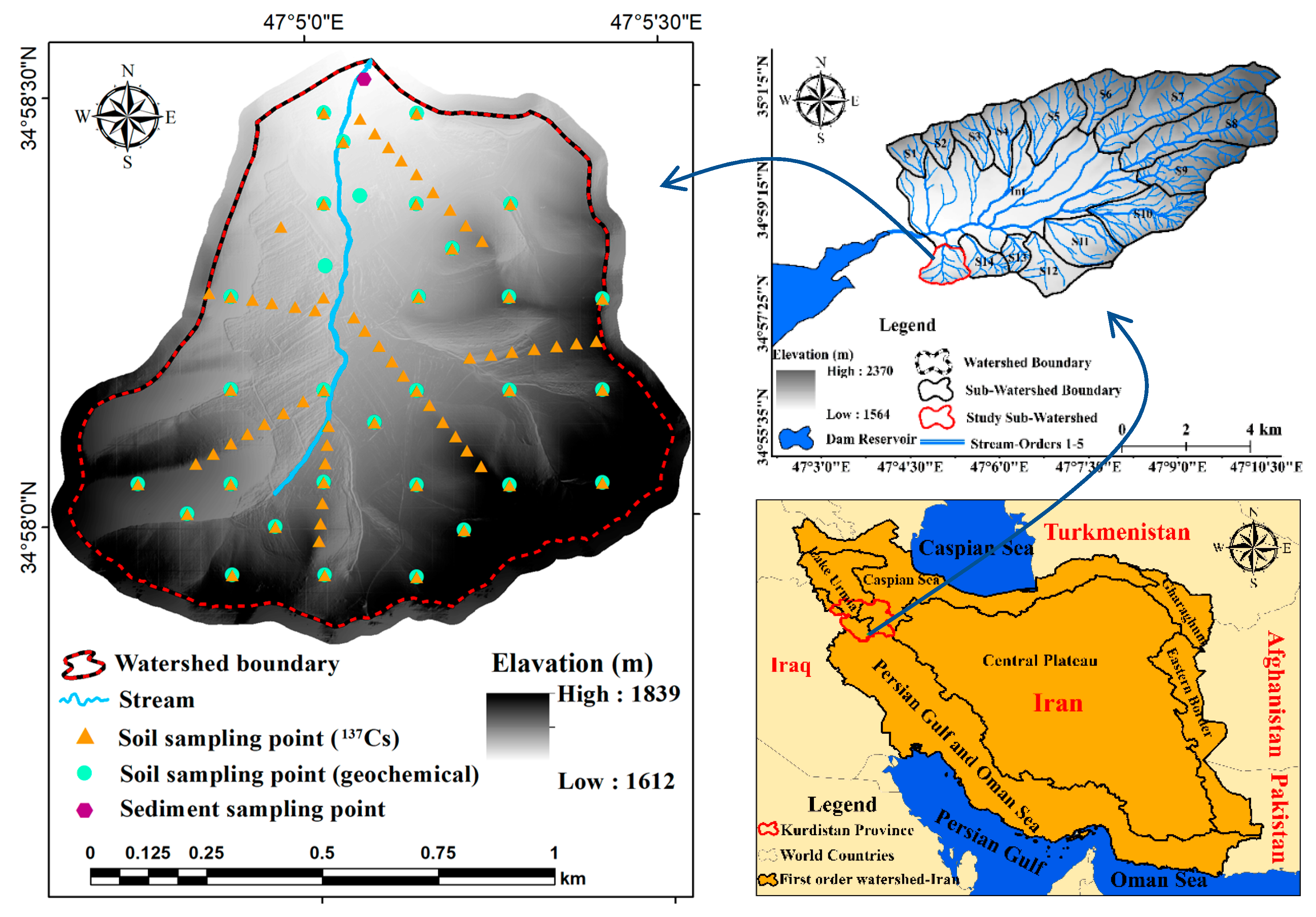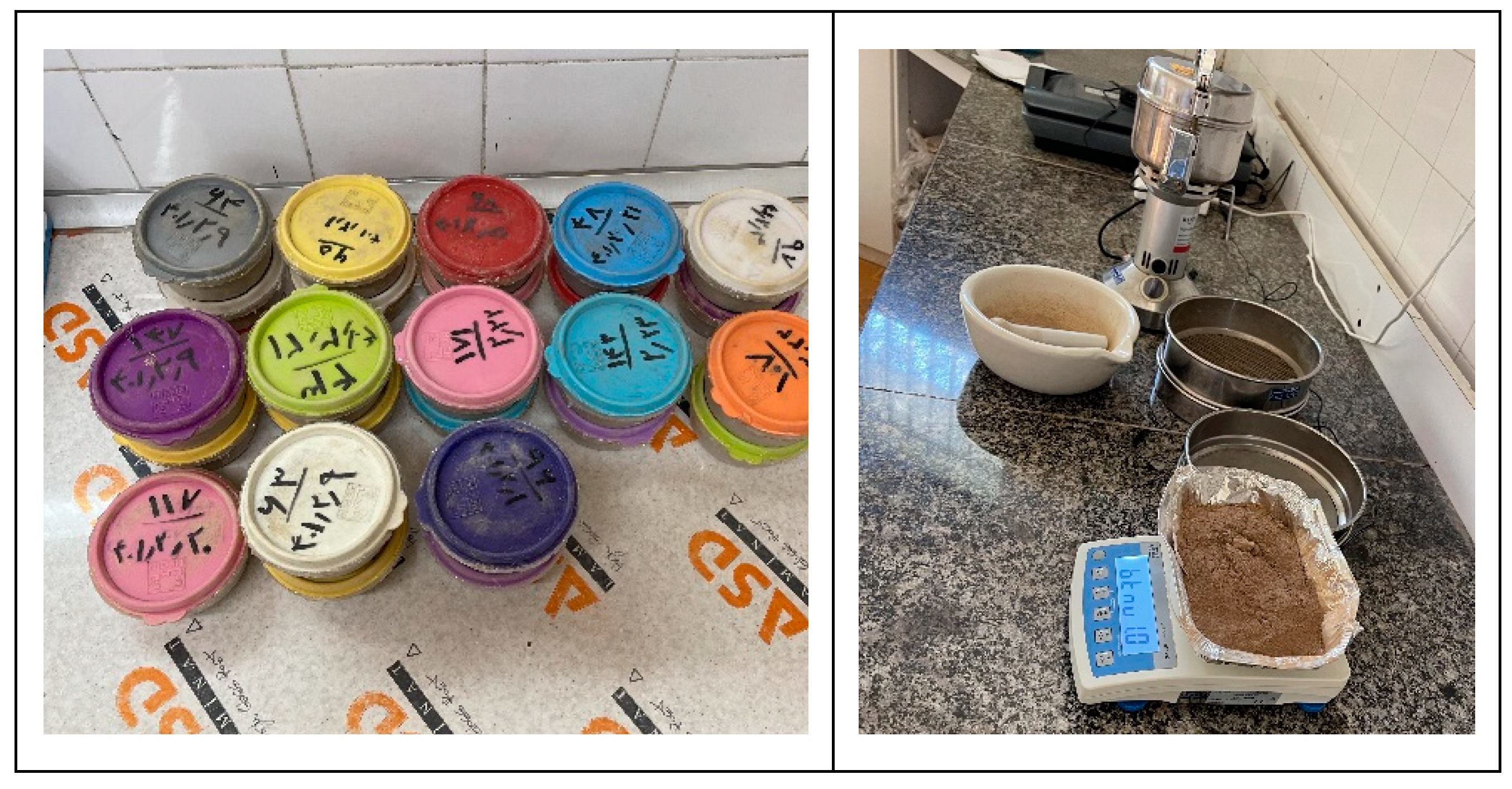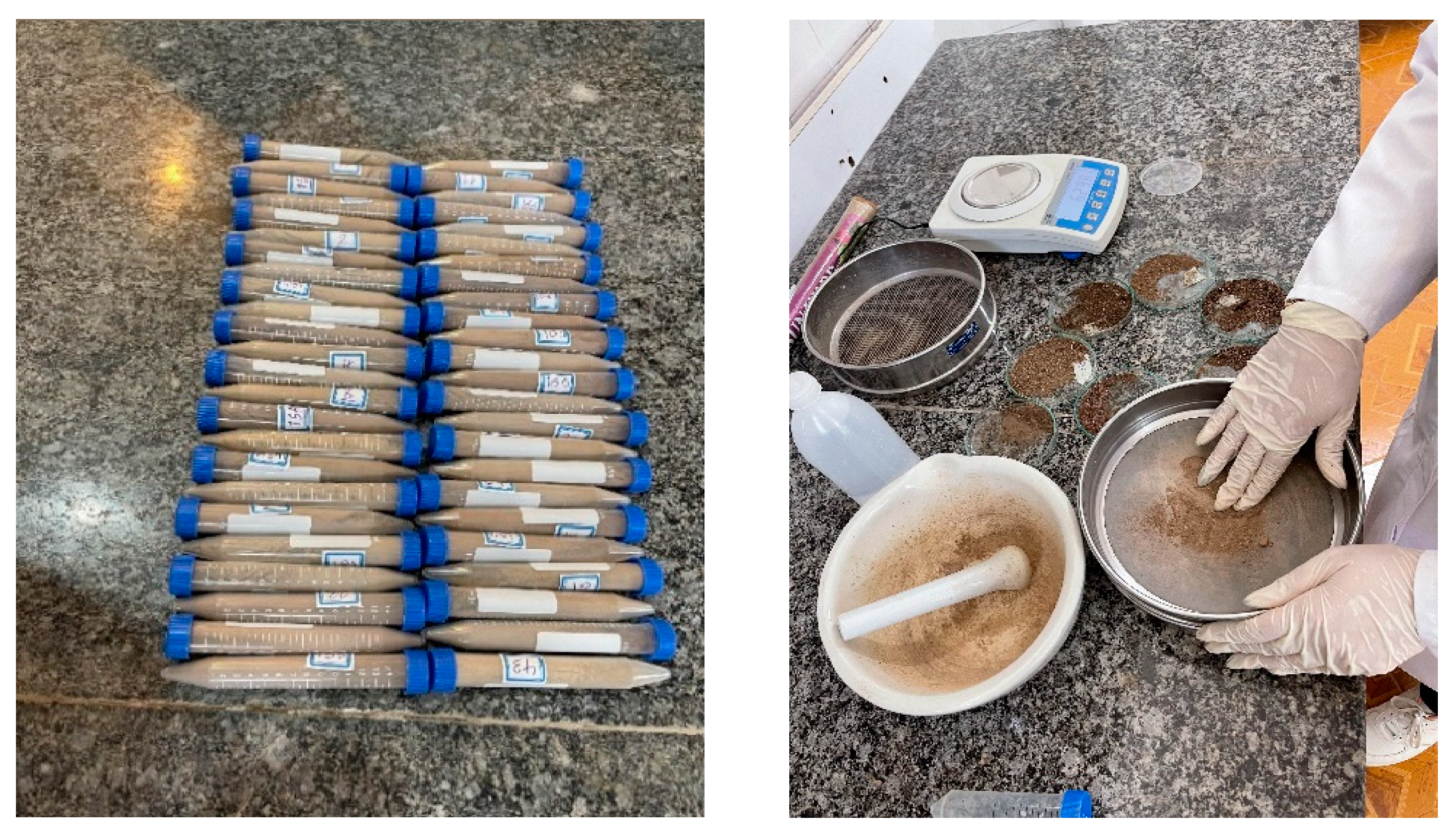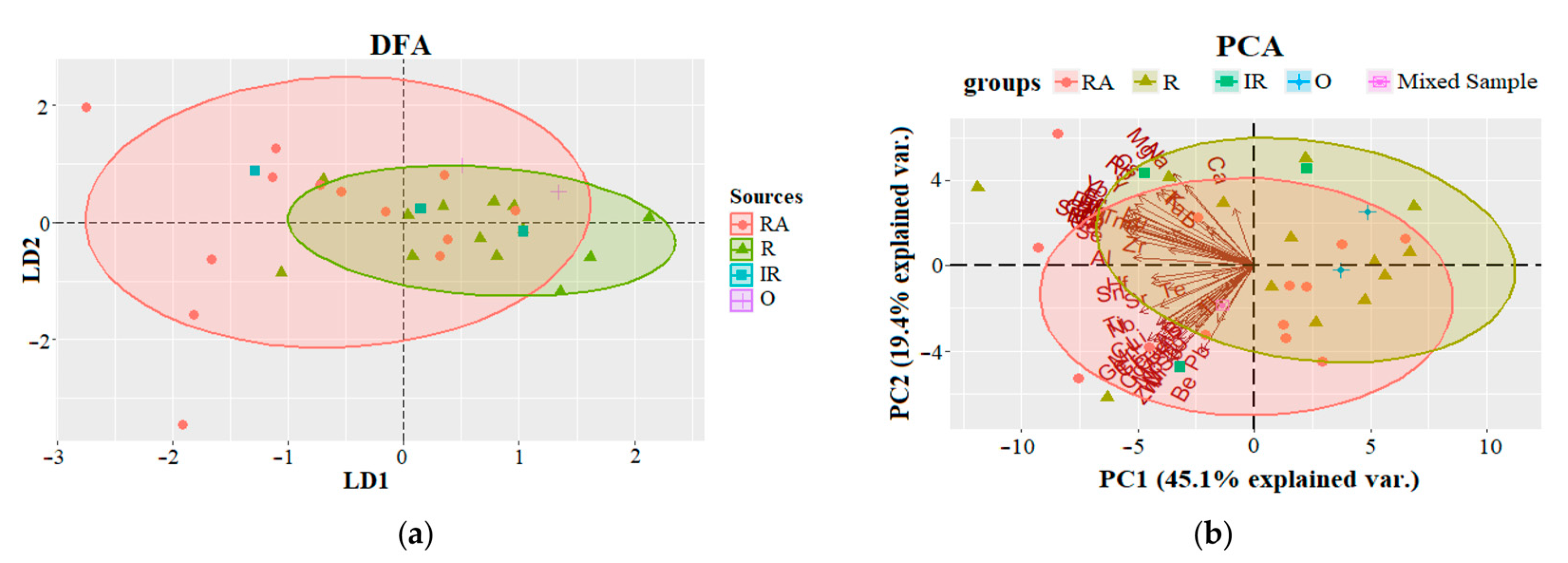Temporal Changes in the Average Contribution of Land Uses in Sediment Yield Using the 137Cs Method and Geochemical Tracers
Abstract
1. Introduction
2. Materials and Methods
2.1. Study Area
2.2. Estimating the Average Contribution of Land Uses in Sediment Yield Using 137Cs
2.3. Estimating the Average Contribution of Land Uses in Sediment Yield Using Geochemical Characteristics
3. Results and Discussion
3.1. Results of the Average Contribution of Land Uses in Sediment Yield Using 137Cs
3.2. Results of the Average Contribution of Land Uses in Sediment Yield Using Geochemical Characteristics
4. Limitations
5. Conclusions
Author Contributions
Funding
Data Availability Statement
Acknowledgments
Conflicts of Interest
References
- Alatorre, L.; Beguería, S.; García-Ruiz, J. Regional scale modeling of hillslope sediment delivery: A case study in the Barasona Reservoir watershed (Spain) using WATEM/SEDEM. J. Hydrol. 2010, 391, 109–123. [Google Scholar] [CrossRef]
- Bhattacharya, R.; Chatterjee, N.; Das, K. Estimation of erosion susceptibility and sediment yield in ephemeral channel using RUSLE and SDR model: Tropical Plateau Fringe Region, India. In Gully Erosion Studies from India and Surrounding Regions; Springer: Berlin/Heidelberg, Germany, 2020; pp. 163–185. [Google Scholar] [CrossRef]
- Collin, A.L.; Pulley, S.; Foster, I.D.L.; Gellis, A.; Porto, P.; Horowitz, A.J. Sediment source fingerprinting for catchment management: A review. J. Environ. Manag. 2017, 194, 86–108. [Google Scholar] [CrossRef] [PubMed]
- Chen, F.; Chen, S.; Zhang, X.; Chen, J.; Wang, X.; Gowan, E.J.; Qiang, M.; Dong, G.; Wang, Z.; Li, Y.; et al. Asian dust-storm activity dominated by Chinese dynasty changes since 2000 BP. Nat. Commun. 2020, 11, 992. [Google Scholar] [CrossRef] [PubMed]
- Bastala, S.; Dialynas, Y.G.; Bras, R.L.; Noto, L.V.; Istanbulluoglu, E. The role of vegetation on gully erosion stabilization at a severely degraded landscape: A case study from Calhoun Experimental Critical Zone Observatory. Geomorphology 2018, 308, 25–39. [Google Scholar] [CrossRef]
- Devátý, J.; Dostál, T.; Hösl, R.; Krása, J.; Strauss, P. Effects of historical land use and land pattern changes on soil erosion—Case studies from Lower Austria and Central Bohemia. LUP 2019, 82, 674–685. [Google Scholar] [CrossRef]
- Zarei, R.; Khaledi Darvishan, A.; Porto, P.; Zare, M.R. Using radiotracers and topographic metrics for sediment budgeting at pixel and hillslope scales: A case study from western Iran. Ecol. Indic. 2024, 167, 112711. [Google Scholar] [CrossRef]
- Collins, A.L.; Walling, D.E. Documenting catchment suspended sediment sources: Problems, approaches and prospects. Prog. Phys. Geogr. 2004, 28, 159–196. [Google Scholar] [CrossRef]
- Franz, C.; Makeschin, F.; Weiß, H.; Lorz, C. Sediments in urban river basins: Identification of sediment sources within the Lago Paranoá catchment, Brasilia DF, Brazil—Using the fingerprint approach. Sci. Total Environ. 2014, 466–467, 513–523. [Google Scholar] [CrossRef]
- Gruszowski, K.E.; Foster, I.D.L.; Lees, J.A.; Charlesworth, S.M. Sediment sources and transport pathways in a rural catchment, Herefordshire, UK. Hydrol. Proc. 2003, 17, 2665–2681. [Google Scholar] [CrossRef]
- Walling, D.E. Tracing suspended sediment sources in catchments and river systems. Sci. Total Environ. 2005, 344, 159–184. [Google Scholar] [CrossRef]
- Koiter, A.J.; Owens, P.N.; Petticrew, E.L.; Lobb, D.A. The behavioural characteristics of sediment properties and their implications for sediment fingerprinting as an approach for identifying sediment sources in river basins. Earth-Sci. Rev. 2013, 125, 24–42. [Google Scholar] [CrossRef]
- Martínez-Carreras, N.; Krein, A.; Gallart, F.; Iffly, J.F.; Pfister, L.; Haffman, L.; Owens, P.N. Assessment of different parameter for discriminating potentioal suspende sediment sources and provenance: A multi scale study in Luxembourg. Geomorphology 2010, 11, 118–129. [Google Scholar] [CrossRef]
- Porto, P.; Walling, D.E.; Callegari, G. Investigating sediment sources within a small catchment in southern Italy. In Sediment; Budgets, I., Walling, D.E., Horowitz, A.J., Eds.; IAHS Publication 291; IAHS Press: Wallingford, UK, 2005; pp. 113–122. [Google Scholar]
- Rogowsky, A.S.; Tamura, T. Movement of 137Cs by runoff, erosion and infiltration on the alluvial Captina silt loam. Health Phys. 1965, 11, 1333–1340. [Google Scholar] [CrossRef]
- Ritchie, J.C.; McHenry, J.R. Determination of fallout 137CS and naturally occurring gamma-ray emitters in sediments. Int. J. Appl. Radiat. Isot. 1973, 24, 575–578. [Google Scholar] [CrossRef]
- Motha, J.A.; Wallbrink, P.J.; Hairsine, P.B.; Grayson, R.B. Tracer properties of eroded sediment and source material. Hydrol. Proc. 2002, 16, 1983–2000. [Google Scholar] [CrossRef]
- Caitcheon, G.; Douglas, G.; Palmer, M. Sediment Source Tracing in the Lake Burragorang Catchment. CSIRO Land Water Sci. Rep. Canberra 2006, 47, 28. [Google Scholar]
- Douglas, G.; Caitcheon, G.; Palmer, M. Sediment source identification and residence times in the Maroochy River estuary, southeast Queensland, Australia. Environ. Geol. 2009, 57, 629–639. [Google Scholar] [CrossRef]
- Hughes, A.O.; Olley, J.M.; Croke, J.C.; McKergow, L.A. Sediment source changes in a dry-tropical catchment. Geomorphology 2009, 104, 262–275. [Google Scholar] [CrossRef]
- D’Haen, K.; Verstraeten, G.; Dusar, B.; Degryse, P.; Haex, J.; Waelkens, M. Unravelling changing sediment sources in a Mediterranean mountain catchment: A Bayesian fingerprinting approach. Hydrol. Proc. 2013, 27, 896–910. [Google Scholar] [CrossRef]
- Lizaga, I.; Latorre, B.; Gaspar, L.; Navas, A. FingerPro: An R package for tracking the provenance of sediment. Water Resour. Manag. 2020, 34, 3879–3894. [Google Scholar] [CrossRef]
- Zapata, F. Handbook for the Assessment of Soil Erosion and Sedimentation Using Environmental Radionuclides; Kluwer Academic Publishers: Dordrecht, The Netherland, 2003; Volume 219, pp. 9348054–9348059. [Google Scholar] [CrossRef]
- Sedighi, F.; Khaledi Darvishan, A.; Zare, M.R. Effect of watershed geomorphological characteristics on sediment redistribution. Geomorphology 2021, 375, 107559. [Google Scholar] [CrossRef]
- Dercon, G.; Deckers, J.; Govers, G.; Poesen, J.; Sánchez, H.; Vanegas, R.; Ramírez, M.; Loaiza, G. Spatial variability in soil properties on slow-forming terraces in the Andes region of Ecuador. Soil Tillage Res. 2003, 72, 31–41. [Google Scholar] [CrossRef]
- Walling, D.E.; He, Q.; Zhang, Y. Conversion models and related software. In: Guidelines for Using Fallout Radionuclides to Assess Erosion and Effectiveness of Soil Conservation Strategies. In IAEA-TECDOC-1741; IAEA Publisher: Vienna, Austria, 2014; Volume 46, pp. 125–148. [Google Scholar]
- Chiu, Y.J.; Chang, K.T.; Chen, Y.C.; Chao, J.H.; Lee, H.Y. Estimation of soil erosion rates in a subtropical mountain watershed using 137Cs radionuclide. Nat. Hazards 2011, 59, 271–284. [Google Scholar] [CrossRef]
- Walling, D.E.; He, Q.; Whelan, P.A. Using 137Cs measurements to validate the application of the AGNPS and ANSWERS erosion and sediment yield models in two small Devon catchments. Soil Tillage Res. 2003, 69, 27–43. [Google Scholar] [CrossRef]
- Porto, P.; Walling, D.E.; Callegari, G. Using repeated 137Cs and 210Pbex measurements to establish sediment budgets for different time windows and explore the effect of connectivity on soil erosion rates in a small experimental catchment in Southern Italy. Land Degrad. Dev. 2018, 29, 1819–1832. [Google Scholar] [CrossRef]
- Lamba, J.; Karthikeyan, K.G.; Thompson, A.M. Apportionment of suspended sediment sources in an agricultural watershed using sediment fingerprinting. Geoderma 2015, 239–240, 25–33. [Google Scholar] [CrossRef]
- Smith, H.G.; Blake, W.H. Sediment fingerprinting in agricultural catchments: A critical re-examination of source discrimination and data corrections. Geomorphology 2014, 204, 177–191. [Google Scholar] [CrossRef]
- Boudreault, M.; Koiter, A.J.; Lobb, D.A.; Liu, K.; Benoy, G.; Owens, P.N.; Li, S. Comparison of sampling designs for sediment source fingerprinting in an agricultural watershed in Atlantic Canada. J. Soils Sediments 2019, 19, 3302–3318. [Google Scholar] [CrossRef]
- Li, T.; Sun, G.; Yang, C.; Liang, K.; Ma, S.; Huang, L.; Luo, W. Source apportionment and source-to-sink transport of major and trace elements in coastal sediments: Combining positive matrix factorization and sediment trend analysis. Sci. Total Environ. 2019, 601, 344–356. [Google Scholar] [CrossRef] [PubMed]
- Wallbrink, P.J.; Croke, J. A combined rainfall simulator and tracer approach to assess the role of Best Management Practices in minimising sediment redistribution and loss in forests after harvesting. For. Ecol. Manag. 2002, 170, 217–232. [Google Scholar] [CrossRef]
- Collins, A.L.; Walling, D.E.; Webb, L.; King, P. Apportioning catchment scale sediment sources using a modified composite fingerprinting technique incorporating property weightings and prior information. Geoderma 2010, 155, 249–261. [Google Scholar] [CrossRef]
- Gholami, H.; Middleton, N.; NazariSamani, A.A.; Wasson, R. Determining contribution of sand dune potential sources using radionuclides, trace and major elements in central Iran. Arab. J. Geosci. 2017, 10, 163–171. [Google Scholar] [CrossRef]
- Nosrati, K.; Ahmadi, F. Investigating of Seasonal Change Effects on Suspended Sediment Yield Using Geochemical Tracers. Iran J. Geol. 2018, 12, 60–73. Available online: http://geology.saminatech.ir/en/Article/9601 (accessed on 28 September 2024).
- Smith, H.G.; Karam, D.S.; Lennard, A.T. Evaluating tracer selection for catchment sediment fingerprinting. J. Soils Sediments 2018, 18, 3005–3019. [Google Scholar] [CrossRef]
- Vale, S.; Swales, A.; Smith, H.G.; Olsen, G.; Woodward, B. Impacts of tracer type, tracer selection, and source dominance on source apportionment with sediment fingerprinting. Sci. Total Environ. 2022, 831, 154832. [Google Scholar] [CrossRef] [PubMed]
- Haji, K.; Khaledi Darvishan, A.; Mostafazadeh, R. Soil erosion and sediment sourcing in the Hyrcanian forests, Northern Iran: An integration approach of the G2loss model and sediment fingerprinting technique. Model. Earth Syst. Environ. 2024, 10, 1897–1914. [Google Scholar] [CrossRef]
- Mohammadi, M.; Khaledi Darvishan, A.; Bahramifar, N.; Alavi, S.J. Spatio-temporal suspended sediment fingerprinting under different land management practices. Int. J. Sediment. Res. 2023, 38, 481–493. [Google Scholar] [CrossRef]
- Lesschen, J.P.; Cammeraat, L.H.; Nieman, T. Erosion and terrace failure due to agricultural land abandonment in a semi-arid environment. Earth Surf. Process. Landf. 2008, 33, 1574–1584. [Google Scholar] [CrossRef]
- Cerdà, A.; Rodrigo-Comino, J.; Novara, A.; Brevik, E.C.; Vaezi, A.R.; Pulido, M.; Giménez-Morera, A.; Keesstra, S.D. Long-term impact of rainfed agricultural land abandonment on soil erosion in the Western Mediterranean basin. Prog. Phys. Geogr. 2018, 42, 202–219. [Google Scholar] [CrossRef]
- Rodrigo-Comino, J.; Martínez-Hernández, C.; Iserloh, T.; Cerdà, A. Contrasted impact of land abandonment on soil erosion in Mediterranean agriculture fields. Pedosphere 2018, 28, 617–631. [Google Scholar] [CrossRef]
- Kheirfam, H.; Sadeghi, S.H.; Darki, B.Z. Soil conservation in an abandoned agricultural rain-fed land through inoculation of cyanobacteria. Catena 2020, 187, 104341. [Google Scholar] [CrossRef]
- Lana-Renault, N.; Nadal-Romero, E.; Cammeraat, E.; Llorente, J.A. Critical environmental issues confirm the relevance of abandoned agricultural land. Water 2020, 12, 1119. [Google Scholar] [CrossRef]
- Liu, M.; Han, G.; Li, X. Contributions of soil erosion and decomposition to SOC loss during a short-term paddy land abandonment in Northeast Thailand. Agric. Ecosyst. Environ. 2021, 321, 107629. [Google Scholar] [CrossRef]
- Khorchani, M.; Gaspar, L.; Nadal-Romero, E.; Arnaez, J.; Lasanta, T.; Navas, A. Effects of cropland abandonment and afforestation on soil redistribution in a small Mediterranean mountain catchment. Int. Soil Water Conserv. Res. 2023, 11, 339–352. [Google Scholar] [CrossRef]
- Sitaula, R.; Sharma, P.; Chidi, C.L. Agricultural land abandonment and its impact on soil erosion in the Madi Watershed, Gandaki Province, Nepal. Geogr. J. Nepal. 2024, 19, 53–70. [Google Scholar] [CrossRef]
- Lizaga, I.; Gaspar, L.; Latorre, B.; Navas, A. Variations in transport of suspended sediment and associated elements induced by rainfall and agricultural cycle in a Mediterranean agroforestry catchment. J. Environ. Manag. 2020, 272, 111020. [Google Scholar] [CrossRef]
- Chen, F.; Wang, X.; Li, X.; Wang, J.; Xie, D.; Ni, J.; Liu, Y. Using the sediment fingerprinting method to identify the sediment sources in small catchments with similar geological conditions. Agric. Ecosyst. Environ. 2019, 286, 106655. [Google Scholar] [CrossRef]
- Gaspar, L.; Blake, W.H.; Lizaga, I.; Latorre, B.; Navas, A. Particle size effect on geochemical composition of experimental soil mixtures relevant for unmixing modelling. Geomorphology 2022, 403, 108178. [Google Scholar] [CrossRef]
- Karimi, N.; Gholami, L.; Kavian, A.; Khaledi Darvishan, A. Determination of specific contribution of suspended sediment sources in Vaz watershed using geochemical properties. J. Ecohydrol. 2022, 9, 705–718. (In Persian) [Google Scholar] [CrossRef]
- Eblaghian, A.; Ali, A.A.; Radmanesh, F.; Zarei, H. Trend Analysis of Temperature, Precipitation, and Relative Humidity Changes in Iran. Irrig. Sci. Eng. 2019, 42, 197–212. [Google Scholar]







| Transformation Model | Model Inputs |
|---|---|
| Mass balance model II | Year of Tillage Commencement, Bulk density of soil, Tillage depth Proportion factor (ϒ), Relaxation depth (H), Migration rate (V), Annual fallout of radionuclide |
| Diffusion and migration model |
| Land Uses/Covers | Orchard | Rangeland | Irrigated Agriculture | Rainfed Agriculture | Road | Stream | Rock | Total |
|---|---|---|---|---|---|---|---|---|
| Area (ha) | 0.04 | 46.17 | 1.29 | 52.32 | 1.03 | 0.54 | 0.75 | 102.14 |
| Area (%) | 0.04 | 45.20 | 1.26 | 51.22 | 1.01 | 0.53 | 0.73 | 100.00 |
| Contribution (%) | 3.78 | 8.93 | 1.80 | 85.49 | - | - | - | - |
| land uses erosion (t y−1) | −19.90 | −47.02 | −9.51 | −450.43 | - | - | - | - |
| Specific Contribution (% per ha) | 94.50 | 0.19 | 1.40 | 1.63 | - | - | - | - |
| Gross erosion (t y−1) | −526.87 | - | - | - | - | |||
| Test | Removed Trackers | Remaining Trackers |
|---|---|---|
| RT | Al, Ba, Be, Fe, Ga, Lu, Pb, Sn, Sr, Te, Tm | Na, K, Ca, Mg, Li, B, Sc, Ti, V, Cr, Mn, Co, Cu, Zn, Ge, As, Se, Rb, Y, Zr, Nb, Sb, Cs, La, Ce, Pr, Nd, Sm, Eu, Ni, Mo, Hf, Gd, Tb, Dy, Ho, Er, Yb, Ta, W, Hg, Tl, Bi, Th, U |
| KW | Na, K, Ca, Mg, Li, B, Sc, Ti, V, Cr, Mn, Co, Cu, Zn, Ge, As, Se, Rb, Y, Zr, Nb, Sb, Cs, La, Ce, Pr, Nd, Sm, Eu, Gd, Tb, Dy, Ho, Er, Yb, Ta, W, Hg, Tl, Bi, Th, U | Ni, Mo, Hf |
| Land Uses/Covers | Orchard | Rangeland | Irrigated Agriculture | Rainfed Agriculture | Road | Stream | Rock | Total |
|---|---|---|---|---|---|---|---|---|
| Area (ha) | 0.63 | 52.54 | 1.54 | 45.65 | 0.59 | 0.36 | 0.81 | 102.14 |
| Area (%) | 0.62 | 51.45 | 1.51 | 44.69 | 0.58 | 0.35 | 0.80 | 100.00 |
| Contribution (%) | 4.72 | 7.96 | 15.06 | 72.26 | - | - | - | - |
| Specific Contribution (% per ha) | 7.49 | 0.15 | 9.78 | 1.58 | - | - | - | - |
| GOF | 0.78 | - | - | - | - | |||
| Known Sediment Source Contributions (%) | Predicted Sediment Source Contributions (%) | RMSE | MAE | ||||||
|---|---|---|---|---|---|---|---|---|---|
| RA | R | IA | O | RA | R | IA | O | ||
| 25 | 25 | 25 | 25 | 24.2 | 19.9 | 28.1 | 27.8 | 3.3 | 3.0 |
| 100 | 0 | 0 | 0 | 90.7 | 0.7 | 6.0 | 2.6 | 5.7 | 4.7 |
| 0 | 100 | 0 | 0 | 1.9 | 87.2 | 5.6 | 5.3 | 7.5 | 6.4 |
| 0 | 0 | 100 | 0 | 2.6 | 3.1 | 91.5 | 2.8 | 4.9 | 4.3 |
| 0 | 0 | 0 | 100 | 0.4 | 2.6 | 3.7 | 93.3 | 4.0 | 3.4 |
| 50 | 25 | 12.5 | 12.5 | 42.9 | 28.7 | 8.7 | 19.7 | 5.7 | 5.5 |
| 25 | 50 | 12.5 | 12.5 | 20.9 | 48.8 | 14.8 | 15.5 | 2.9 | 2.7 |
| 25 | 6.25 | 56.25 | 12.5 | 26.9 | 5.4 | 62.5 | 5.2 | 4.9 | 4.1 |
| 70 | 10 | 10 | 10 | 75.4 | 6.7 | 13.9 | 4.0 | 4.8 | 4.7 |
| 85 | 5 | 5 | 5 | 79.1 | 4.6 | 13.6 | 2.7 | 5.3 | 4.3 |
| Average | 4.9 | 4.3 | |||||||
Disclaimer/Publisher’s Note: The statements, opinions and data contained in all publications are solely those of the individual author(s) and contributor(s) and not of MDPI and/or the editor(s). MDPI and/or the editor(s) disclaim responsibility for any injury to people or property resulting from any ideas, methods, instructions or products referred to in the content. |
© 2024 by the authors. Licensee MDPI, Basel, Switzerland. This article is an open access article distributed under the terms and conditions of the Creative Commons Attribution (CC BY) license (https://creativecommons.org/licenses/by/4.0/).
Share and Cite
Ghaderi Dehkordi, N.; Khaledi Darvishan, A.; Zare, M.R.; Porto, P. Temporal Changes in the Average Contribution of Land Uses in Sediment Yield Using the 137Cs Method and Geochemical Tracers. Water 2025, 17, 73. https://doi.org/10.3390/w17010073
Ghaderi Dehkordi N, Khaledi Darvishan A, Zare MR, Porto P. Temporal Changes in the Average Contribution of Land Uses in Sediment Yield Using the 137Cs Method and Geochemical Tracers. Water. 2025; 17(1):73. https://doi.org/10.3390/w17010073
Chicago/Turabian StyleGhaderi Dehkordi, Negin, Abdulvahed Khaledi Darvishan, Mohamad Reza Zare, and Paolo Porto. 2025. "Temporal Changes in the Average Contribution of Land Uses in Sediment Yield Using the 137Cs Method and Geochemical Tracers" Water 17, no. 1: 73. https://doi.org/10.3390/w17010073
APA StyleGhaderi Dehkordi, N., Khaledi Darvishan, A., Zare, M. R., & Porto, P. (2025). Temporal Changes in the Average Contribution of Land Uses in Sediment Yield Using the 137Cs Method and Geochemical Tracers. Water, 17(1), 73. https://doi.org/10.3390/w17010073









